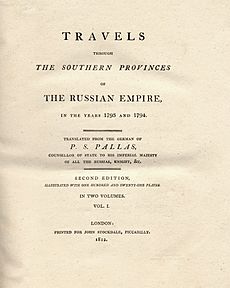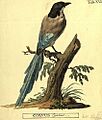Peter Simon Pallas facts for kids
Quick facts for kids
Peter Simon Pallas
|
|
|---|---|
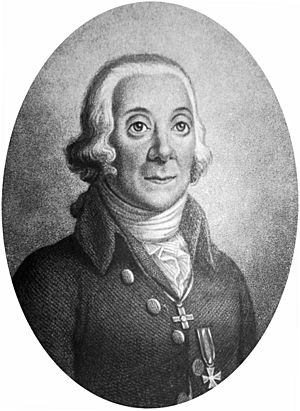 |
|
| Born | 22 September 1741 |
| Died | 8 September 1811 (aged 69) Berlin, Prussia
|
| Alma mater | University of Göttingen University of Halle University of Leiden |
| Known for | Pallasite meteorite Elevation crater theory |
| Scientific career | |
| Fields | Zoology Botany Geography Geology Ethnography Natural history Philology Taxonomy |
| Influences | Simon Pallas |
Peter Simon Pallas (born September 22, 1741 – died September 8, 1811) was a famous scientist from Prussia. He was many things: a zoologist (someone who studies animals), a botanist (someone who studies plants), and an explorer. He also studied geography, geology, and natural history. Pallas learned about nature at different universities in Germany. He spent most of his career, from 1767 to 1810, working in the Russian Empire.
Contents
Peter Pallas's Life and Discoveries
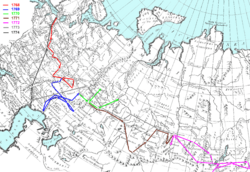
Peter Simon Pallas was born in Berlin, which was part of Prussia at the time. His father, Simon Pallas, was a professor of surgery. Peter was taught by private teachers and became very interested in nature. He later went to the University of Halle and the University of Göttingen. In 1760, he moved to the University of Leiden and earned his doctor's degree when he was only 19 years old.
Pallas traveled around the Dutch Republic and to London. He wanted to improve his knowledge of medicine and surgery. He then settled in The Hague. His new way of classifying animals was highly praised by another famous scientist, Georges Cuvier. Pallas wrote a book called Miscellanea Zoologica in 1766. This book described several animals that were new to science. He had found these animals in Dutch museum collections.
Pallas had planned a trip to Southern Africa and the East Indies. However, his father called him back to Berlin, so the trip did not happen. In Berlin, he started working on another important book, Spicilegia Zoologica (1767–1780).
Exploring the Russian Empire
In 1767, Catherine II of Russia invited Pallas to be a professor. He joined the St Petersburg Academy of Sciences. From 1768 to 1774, Pallas led a big expedition. He traveled through central Russia, the Urals, West Siberia, the Altay, and Transbaikal. During this trip, he collected many natural history samples for the academy.
He explored the Caspian Sea, the Ural and Altai Mountains, and the upper Amur River. He even reached as far east as Lake Baikal. Pallas sent regular reports back to St Petersburg. These reports were later put together and published as Reise durch verschiedene Provinzen des Russischen Reichs (meaning "Journey through various provinces of the Russian Empire"). This work had three volumes, published between 1771 and 1776.
His reports covered many different topics. He wrote about geology (the study of Earth's rocks and soil) and mineralogy (the study of minerals). He also included reports on the native people of Eurasia and their traditional religions. Plus, he described many new plants and animals he found. In 1776, Pallas was chosen as a foreign member of the Royal Swedish Academy of Sciences.
Life in St Petersburg
Pallas settled in St Petersburg and became a favorite of Empress Catherine II. He taught natural history to the Grand Dukes Alexander and Constantine. He was given plants collected by other scientists to help him create Flora Rossica (1784–1815). This was a book about all the plants found in Russia. He also started working on his Zoographica Rosso-Asiatica (1811–31), which described animals from Russia and Asia.
Pallas also published a report about the travels of Johann Anton Güldenstädt in the Caucasus region. The Empress bought Pallas's large collection of natural history items for 2,000 rubles. This was more than he asked for, and she let him keep the collection for his lifetime. During this time, Pallas helped plan the Mulovsky expedition, but it was canceled in 1787.
Later Expeditions and Return to Berlin

Between 1793 and 1794, Pallas led another expedition. This time, he went to southern Russia, visiting the Crimea and the Black Sea. His daughter, his new wife, an artist, servants, and a military escort joined him. His first wife had passed away in 1782.
In February 1793, they traveled to Saratov and then downriver to Tsaritsyn. They explored the land to the east. In August, they traveled along the Caspian Sea and into the Caucasus Mountains. In September, they went to the Crimea and spent the winter in Simferopol. Pallas spent early 1794 exploring the southeast. In July, they traveled up the valley of the Dnieper River. They arrived back in St Petersburg in September.
Pallas wrote about this journey in his book P. S. Pallas Bemerkungen auf einer Reise in die Südlichen Statthalterschaften des Russischen Reichs (1799–1801). Empress Catherine II gave him a large estate in Simferopol. Pallas lived there until his second wife died in 1810. Then, Emperor Alexander allowed him to leave Russia. Pallas returned to Berlin, where he passed away the next year. His grave is in a cemetery in Berlin-Kreuzberg, south of Hallesches Tor.
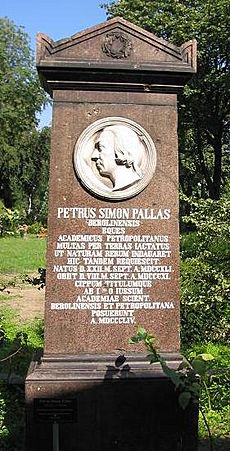
In 1809, he became a member of the Royal Netherlands Academy of Arts and Sciences.
What is a Pallasite?
In 1772, someone showed Pallas a large piece of metal, weighing 680 kilograms (about 1500 pounds). It had been found near Krasnoyarsk. Pallas arranged for this metal to be moved to St Petersburg. Scientists later studied the metal. They found it was a new type of stony-iron meteorite.
This new type of meteorite was named pallasite after him. The specific meteorite Pallas found is called Krasnojarsk or sometimes Pallas Iron.
How Pallas is Remembered
Many animals were first described by Pallas. His last name is used in their common names. Some examples include:
- Pallas's glass lizard
- Pallas's viper
- Pallas's cat
- Pallas's long-tongued bat
- Pallas's tube-nosed bat
- Pallas's squirrel
- Pallas's leaf warbler
- Pallas's cormorant
- Pallas's fish-eagle
- Pallas's gull
- Pallas's sandgrouse
- Pallas's rosefinch
- Pallas's grasshopper warbler
He is also honored in the scientific names of animals described by other scientists. These include:
- The Dagestani tortoise (Testudo graeca pallasi)
- Pallas's pika (Ochotona pallasi)
- Pallas's reed bunting (Emberiza pallasi)
- The East Siberian grayling (Thymallus pallasii)
- The Pacific herring (Clupea pallasii)
A plant genus, Petrosimonia, is also named after him. These are flowering plants in the family Amaranthaceae.
Streets in Berlin and Castrop-Rauxel are named Pallasstraße. Pallasovka, a city in Volgograd Oblast, Russia, is named after him, and there is a monument to him there.
An asteroid is named after him: 21087 Petsimpallas. A Belgian astronomer, Eric Elst, named another asteroid "Sarapul 26851". He did this because Pallas wrote about how much he liked the city of Sarapul, Russia.
Pallas became a member of the American Philosophical Society in 1791.
Images for kids
See also
 In Spanish: Peter Simon Pallas para niños
In Spanish: Peter Simon Pallas para niños


